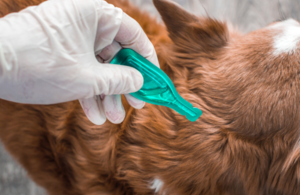Ectoparasiticide Veterinary Medicinal Products Containing Fipronil, Imidacloprid, and Permethrin
Ectoparasiticide veterinary medicinal products and reporting adverse events.

You may have heard, or read recently, that banned pesticides (Fipronil, Imidicloprid, Permethrin) are still being used in veterinary medicines for cats, dogs and other companion animals. Whilst the active substances may be the same, their use in veterinary medicinal products is quite different and regulated under a separate legal framework.
These veterinary medicinal products treat fleas and ticks and are known as ectoparasiticides. Fleas and ticks can cause distress and discomfort to pets, and they may also cause parasitic disease, which may in some cases be spread to humans (zoonotic disease). It is therefore essential to take a balanced approach in terms of authorising these products.
One of the significant factors taken into account, during independent assessment by the regulator, is balancing the benefits of using a veterinary medicinal product for animal health and welfare reasons, and for the benefits to human health, when weighed against the risks, including risks to the environment. Products will only be authorised where the benefits of use outweigh the risks.
The Veterinary Medicines Directorate (VMD) is the body in the UK with responsibility for authorising veterinary medicinal products. We are responsible for ensuring all veterinary medicines in the United Kingdom are marketed in accordance with the legislation in force (Veterinary Medicines Regulations 2013). Our aim is to protect public health, animal health and the environment and to promote animal welfare by assuring the safety, quality and efficacy of veterinary medicines.
Before a company can market a product, it must first apply for a marketing authorisation. Each application is accompanied by supporting scientific data which are assessed against statutory criteria for quality, safety and efficacy. This assessment process evaluates the benefits of the product and takes account of any potential risks to the environment, to animals, to people who administer the medicine and, for farmed species, to those who may consume produce from treated animals.
A product will only be approved where there is a positive benefit:risk conclusion.
The user risk assessment takes into consideration data on pharmacology and toxicology of the substances included in the product in order to determine the likely hazards to human users (and family members including children, where the products are used in the home), and the likely exposure (routes and extent) of the people involved. These data are then combined in a risk assessment which determines the likely risks and then mitigates for them. The risk mitigations can be in the form of user safety warnings that appear on the product packaging, or in other ways, such as having child-resistant closures.
Once a product has been granted a marketing authorisation it is then subject to post marketing surveillance. The Marketing Authorisation Holder has a legal responsibility to report to the VMD any reports of adverse events it receives relating to the use of the product on the animal, any adverse events experienced by those administering the product to the animal or to animal owners, any adverse events to the environment and also whether there is a lack of efficacy.
Furthermore, we encourage adverse event reporting directly from veterinary surgeons and also from the owners of animals and the general public.
As is the case for human medicines, no veterinary medicine is 100% risk-free. Our pharmacovigilance programmes, however, are there to help ensure that the balance between the benefits and risks of authorised medicines remains favourable in order to safeguard animal health and welfare, and human health.
The VMD’s pharmacovigilance team continuously monitor all authorised veterinary medicinal products for adverse events by analysing reports received. In light of this information, and the possible signals being detected, the VMD has the power to request changes to how the product is used, and this can also include suspension or revocation of the marketing authorisation. Any change, however, must be supported by data to ensure that the proposed amendments are appropriate and that the benefits of authorising the product continue to outweigh the risks.
Based on the pharmacovigilance data we have received, the incidence of adverse events in humans when compared against the volumes of the products sold are noted in the table below.
| Active | Incidence Rate |
|---|---|
| Fipronil sprays (cats and dogs) | 1 adverse event per 10,000 doses administered. |
| Fipronil spot-on (cats, dogs) | <1 adverse event per 10,000 doses administered. |
| Imidacloprid spot-on (dogs, cats, ferrets) | <1 adverse event per 10,000 doses administered. |
| Imidacloprid collars for dogs | <1 adverse event per 10,000 doses administered. |
| Permethrin spot-on for dogs | <1 adverse event per 10,000 doses administered. |
It is important that reports of suspected adverse events are reported to the VMD so that we can continue to monitor the situation for signals that may emerge.
While parasiticides play an essential role in protecting both animal and human health against fleas and ticks and their associated vector-borne diseases, the VMD also recognise the concerns regarding the potential contribution of active substances used in companion animal flea and tick treatments currently being detected in UK surface waters.
The VMD has commissioned research and has formed a cross-governmental Pharmaceuticals in the Environment (PiE) Group. This group is chaired independently of Government and provides a platform for discussion and knowledge exchange relating to pharmaceuticals in the environment. The aim is to develop a co-ordinated strategy to reduce the impacts of pharmaceuticals on the environment.